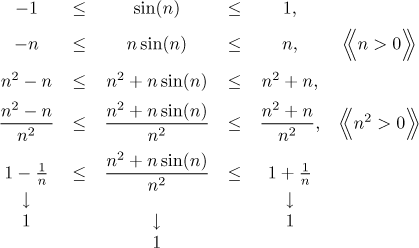Problem: Evaluate the following limit (if it exists)
![]()
Solution:
What happens if we put infinity into this expression? We know that
![]()
If we had only the usual l'Hospital rule and hoped to use it, we would have to prove that the numerator tends to infinity. This is actually true (see below), but fortunately we have the general version, too, that applies to "something over infinity", so we do not have to do more analysis and apply it right away (after changing to functions):

How did we get that "0" in the last line? We have a rule "zero times
bounded gives zero" (see the box
comparison and oscillation), which
exactly fits the terms
The l'Hospital rule yielded a sequence that does not have a limit. What does it mean? Since the l'Hospital rule applies only if it gives a limit, it follows that its use was not successful and gives no information about the original sequence. So the given sequence may have a limit or not, we do not know.
What can we do? There are two possible approaches. One is to say, fine, if we
cannot calculate the answer, perhaps we can guess it using
intuitive evaluation. What happens
when n gets large? The sine oscillates between
![]()
Very nice, but how do we prove that the sequence indeed converges to 1? One possibility is suggested by the boundedness of sine: The Squeeze theorem (see the box "comparison and oscillation"). In fact, even if we did not do the guessing, we should start thinking of this box, since it is often applied to limits with oscillating terms that cause troubles.
First we have to find some bounds, then we look at the limits of these bounds. If they happen to be the same, we proved the limit.

We used the fact that
We can also try this:
![]()
The fraction
We will now try some modifications of this problem to see how oscillating expressions behave.
Problem: Find the following limit (if it exists):
![]()
Solution: What happens if n goes to infinity? Just like above, the sine part in the numerator is negligible compared to n2, so we get
![]()
The easiest way to prove it is probably by comparison. Why? Since we guessed that the sequence tends to infinity, we do not really need an upper estimate, it is enough to find a suitable lower estimate to "push the sequence up". Since comparison is easier than squeeze, it is preferable (if it works, that is).
![]()
It worked, our guess was proven.
Problem: Find the following limit (if it exists):
![]()
Solution:
As we argued above, the sine part (that is,
![]()
Now it is clear, the algebra of
DNE says
Problem: Find the following limit (if it exists):
![]()
Solution:
What happens here? Just like in the previous example, the numerator
oscillates between 0 and
![]()
Yes, it worked.
We saw very simple problems here, but they represent the major cases one can have. The main message is that when facing some DNE situation, a lot depends on our experience and intuition.